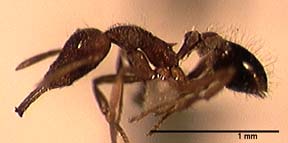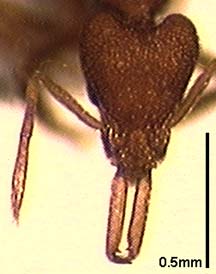Strumigenys JTL-010 Longino ms
Dacetini, Myrmicinae, Formicidae, Hymenoptera, Insecta, Arthropoda, Animalia
John T. Longino, The Evergreen State College, Olympia WA 98505
USA.
longinoj@evergreen.edu
22 April 1997

Specimen: Costa Rica, Prov. Heredia: La Selva Biological Station (C. W. Thompson 221-A). INBIOCRI001254077. Image by J. Longino.
Identification
Apical fork of mandible with single intercalary tooth; mandible with single conspicuous preapical tooth near apical fork; eye composed of approximately 20 facets; gaster finely longitudinally striolate near postpetiolar insertion, remainder smooth and shining; gaster covered with dense brush of flagelliform setae.
Head length 0.579mm, head width 0.445, mandible length 0.348, CI 77, MI 60.
|

Specimen: Costa Rica, Prov. Heredia: La Selva Biological Station (C. W. Thompson 221-A). INBIOCRI001254077. Image by J. Longino. |
Similar species: lanuginosa, JTL-011.
Range
Costa Rica (Atlantic lowlands).
Natural History
Brown and Wilson (1959) summarize the genus as follows:
"Widespread in tropics and warm temperate areas. Primarily forest-dwelling; some species occur in grassland and arid scrub. ... Nests mostly in soil and rotting wood; a few species live in arboreal plant cavities in tropical rain forest. Foraging hypogaeic to epigaeic-arboreal. Food: most species are collembolan feeders; a few are polyphagous predators or occasionally feed on sugary substances..."
JTL-010 occurs in lowland wet forest. It nests in dead wood on the ground.
Selected Records
La Selva: nest in dead wood on ground (Thompson study).
Literature Cited
Brown, W. L., Jr., Wilson, E. O. 1959. The evolution of the dacetine ants. Quarterly Review of Biology 34:278-294.
 Go back to top
Go back to top

